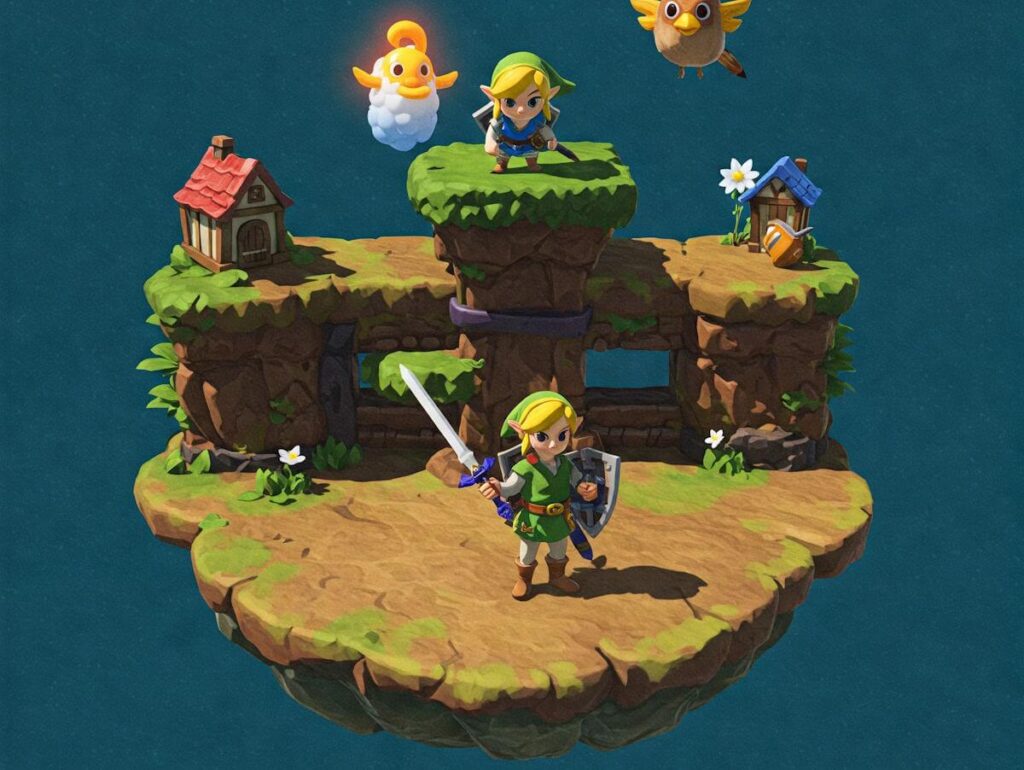The Origin of Link’s Awakening
The Legend of Zelda: Link’s Awakening initially released for the Game Boy in 1993, represents a significant chapter in the illustrious franchise created by Nintendo. Developed by a dedicated team led by Takashi Tezuka, the project sought to push the boundaries of what a handheld console could achieve at the time. The limitations imposed by the Game Boy’s hardware played a crucial role in shaping the game’s unique narrative and design choices.
The narrative of Link’s Awakening diverges from traditional Zelda titles, taking place in the dreamlike Koholint Island instead of the familiar land of Hyrule. This shift in setting allowed the developers to experiment with distinctive characters and storylines, ultimately crafting a rich and engaging world. It was inspired by Tezuka’s personal experiences during a trip to the United States, where he appreciated the idea of a place disconnected from the Zelda canon. This innovation enabled a fresh perspective within the dedicated Zelda community.
The game’s development process was also marked by the integration of gameplay elements that highlighted the limitations of the Game Boy. Developers utilized creative solutions, such as clever puzzle designs and intriguing character interactions, to deliver an immersive and enjoyable experience despite graphical constraints. Moreover, the game distinguished itself with memorable features, including the ability to collect various instruments, providing players with a sense of progression and purpose.
Upon its release, Link’s Awakening garnered critical acclaim and a robust following, establishing itself as a hallmark for handheld gaming, and earning a revered spot within the larger Zelda franchise. Its blend of enchanting storylines, combined with innovative gameplay mechanics, solidified Link’s Awakening as a classic, cherished by players for nearly three decades.
Introducing the Remake: Reasons and Motivations
The decision to remake Link’s Awakening for the Nintendo Switch stems from a desire to introduce this classic title to a new generation of players while ensuring that the original essence remains intact. First released on the Game Boy in 1993, Link’s Awakening is regarded as one of the seminal games in the Zelda franchise, beloved for its unique storyline and whimsical art style. Nintendo recognized the need to bridge the nostalgia of long-time fans with the expectations of modern gamers, which served as a primary motivation for the remake.
Advancements in technology also played a pivotal role in this decision. The Nintendo Switch offers enhanced graphical capabilities and improved gameplay mechanics that were not possible during the original release. By leveraging these advancements, the development team aimed to create a visually stunning experience that retains the charm and the spirit of the original game. The team made use of vibrant, diorama-like visuals that elevate the artistic style, making it appealing to both current and new audiences. The smooth 60 fps performance enhances gameplay fluidity and enriches the overall experience.
Moreover, there is a creative vision underlying the modernization of Link’s Awakening. The developers sought to not only improve the aesthetic aspects but also streamline gameplay mechanics such as controls and combat systems to ensure accessibility for newer players. Retaining core elements, such as the intricate puzzles and engaging storyline, while modernizing some aspects allowed for a nostalgic yet fresh experience. This careful balance of respecting the original material while pushing creative boundaries defines the motivations behind this captivating remake.
Revamping Art and Aesthetics
The transformation of art and aesthetics in the remake of The Legend of Zelda: Link’s Awakening represents a significant evolution from the original game’s pixelated graphics to a vibrant, toy-like visual style. This shift reflects not only technological advancements but also a deliberate artistic vision aimed at breathing new life into a classic title. The development team meticulously crafted character designs that retain the essence of the original while introducing a more three-dimensional look, particularly with the use of expressive facial features and fluid animations.
One of the most striking elements of the remake’s aesthetics is its environmental art. The lush landscapes of Koholint Island have been revitalized, featuring a rich palette of colors that enhances the enchanting atmosphere of the game. Each area is meticulously designed with intricate details, from the vivid flora to the charmingly crafted buildings. This approach honors the beloved original while inviting a new generation of players to experience its charm. The application of depth and shadow brings environments to life, creating an immersive experience that encourages exploration and interaction.
The toy-like aesthetic, characterized by its emphasis on a miniature world, allows for a unique representation that resonates with both nostalgic players and newcomers. The integration of color plays a pivotal role; the vibrant hues not only elevate the visual appeal but also serve to convey the emotional tone of various scenes, establishing a strong connection to the gameplay. The design decisions made by the team enhance the storytelling aspect of the game, making it feel as though players are stepping into a lovingly-crafted diorama. Through this artistic evolution, Link’s Awakening remake captures the spirit of the original while offering a fresh and captivating experience.
Soundtrack Reimagined
The soundtrack of a game plays a pivotal role in shaping the overall experience, and with the remake of The Legend of Zelda: Link’s Awakening, the sound team took a thoughtful approach to re-record and modernize the original score. The original compositions, crafted by the renowned Koji Kondo, have been beloved since the game’s initial release. To honor this legacy while providing a fresh auditory experience, the team set out to weave orchestral elements into the iconic melodies, enhancing both the nostalgic and innovative aspects of the game.
The reimagined soundtrack involved a meticulous process wherein every piece was interpreted through a contemporary lens. The sound team enlisted skilled musicians and expert sound engineers to perform and record the compositions, ensuring that each note resonated with clarity and richness. By incorporating orchestral instruments, the familiar tunes gained new life, inviting players to engage with the music on a deeper level. The use of strings, brass, and woodwinds added grandeur, elevating the emotional weight of key moments throughout Link’s journey.
Furthermore, the sound design not only complemented the gameplay but also served to immerse players in the vibrant world of Koholint Island. The nuanced re-recording captured the essence of the original themes while infusing them with modern production techniques. This careful balance allowed the soundtrack to resonate with both veteran fans and newcomers alike, creating a bridge across generations. The music remains familiar yet transformative, ultimately enriching the gaming experience and allowing players to relive the enchantment of Link’s Awakening with renewed vigor.
Gameplay Mechanics: Balancing Nostalgia and Innovation
The remake of The Legend of Zelda: Link’s Awakening captures the essence of the original game while introducing notable enhancements aimed at improving player experience. The development team undertook a meticulous approach to maintain the nostalgic elements cherished by fans while also integrating new gameplay mechanics. One of the most striking features preserved is the overall dungeon design, along with the classic puzzles that have defined the series for decades. Each room within the dungeons possesses distinct mechanics that require players to strategize and utilize the tools available to solve them, which harkens back to the original’s charm.
In addition to retaining these classic mechanics, Link’s Awakening Remake introduces modern features that enhance accessibility and improve gameplay fluidity. For instance, the game incorporates a more intuitive control scheme, enhancing the way players interact with the environment. The addition of quality-of-life updates, such as the ability to save progress at any point, allows for a more adaptable gaming experience, catering to both seasoned players and newcomers alike.
Moreover, the inclusion of the ‘Chamber Dungeon’ feature exemplifies how the development team balanced innovation with nostalgia. This new mode allows players to create and share their custom dungeons, offering a fresh layer of interactivity that complements the traditional gameplay experience. By providing tools for creativity, players are encouraged to explore the mechanics of dungeon design, further engaging with the core principles of The Legend of Zelda series. While the remake holds onto the beloved aesthetics and gameplay of the original, these thoughtful innovations ensure that Link’s Awakening remains a relevant experience in the modern gaming landscape. This careful equilibrium between nostalgia and modernization is a testament to the developers’ understanding of their audience and their vision for the franchise’s future.
The Role of Fan Feedback
The development of the remake of The Legend of Zelda: Link’s Awakening significantly benefited from the input of its dedicated fan base. In an age where digital communication bridges the gap between creators and players, developers proactively sought insights from the community during various stages of production. Fans, who have cherished the original game since its release in 1993, expressed their thoughts through forums, social media platforms, and fan events, providing crucial feedback that helped shape the direction of the remake.
One of the most prominent aspects highlighted by the community was the desire for authenticity in the gameplay experience. Players communicated their passion for the original graphics, sound, and game mechanics, sparking a dialogue around maintaining the nostalgic elements while enhancing the visual experience. Developers took these concerns seriously, understanding that preserving the essence of the beloved classic was paramount. As a result, the artistic direction leaned toward a style that, while modernized, remained true to the aesthetic charm of the original game.
In addition to graphical fidelity, fans voiced their opinions on character designs and dialogue. Input from players helped ensure that returning characters were faithfully adapted for a contemporary audience, with an emphasis on their personalities and interactions. This responsiveness to fan feedback ultimately fostered a more vibrant and engaging experience in the remake. Moreover, elements such as added quality-of-life improvements, subtly incorporated due to community suggestions, helped in refining the overall gameplay mechanics.
This open dialogue exemplifies how essential fan feedback is in game development, particularly for reimagined classics. By attentively listening to their audience, the developers of The Legend of Zelda: Link’s Awakening Remake successfully created a tribute that resonates with both long-time fans and newcomers to the franchise.
Development Challenges and Triumphs
The journey of creating the remake of The Legend of Zelda: Link’s Awakening was fraught with numerous challenges that tested the skills and resilience of the development team. One of the primary technical hurdles encountered was the need to modernize a classic game while preserving its original charm. The development team aimed to enhance the graphics and integrate new gameplay mechanics without alienating long-time fans. Achieving this delicate balance demanded a great deal of experimentation and introspection, ensuring that any changes made could be justified within the framework of the beloved original.
Team dynamics played a significant role in overcoming these challenges. A collaborative environment allowed diverse ideas to flourish, enabling animators, programmers, and designers to work in synergy. Regular brainstorming sessions fostered a culture of innovation, where team members were encouraged to share their insights and critique each other’s work constructively. This approach not only motivated the team but also acted as a catalyst for creative problem-solving. As difficulties arose—such as coordinating various artistic styles and maintaining consistency across different game segments—the commitment to open communication remained crucial in addressing issues promptly.
Time constraints further complicated the development process. The team faced pressure to release the remake within a specified timeframe while adhering to high standards of quality. This necessitated effective project management techniques, including prioritizing tasks and setting achievable goals. The multifaceted nature of game development, which involves continuous testing, adjustments, and iterations, required the perseverance of the team. Ultimately, diligent planning combined with an agile response to challenges enabled the developers to deliver a remake that not only honored the legacy of the original title but also brought it to a new generation of players. This successful execution proved the team’s ability to transform challenges into triumphs, solidifying Link’s Awakening as a standout title in the franchise’s storied history.
Impact on the Legend of Zelda Franchise
The remake of The Legend of Zelda: Link’s Awakening has significant implications for the broader franchise, highlighting the enduring legacy of one of gaming’s most beloved series. Initially released on the Game Boy in 1993, the original game introduced players to a whimsical yet richly crafted world, full of memorable characters and engaging gameplay. The recent remake not only revitalizes this classic for modern audiences but also serves to reaffirm the franchise’s commitment to quality and innovation.
One of the most profound impacts of the remake is its ability to bridge the generational gap between long-time fans and newcomers. While seasoned players are greeted with nostalgia and familiar gameplay mechanics, new players have the opportunity to experience a gameplay style that paved the way for future titles in the series. The charming visual overhaul, along with updated quality-of-life features, makes the game accessible while retaining the depth and complexity that fans expect from a Zelda title.
This blend of nostalgia and innovation not only reinforces the strong foundations of the franchise but also influences the direction of upcoming games. Future titles are likely to draw inspiration from the successful elements of the remake, balancing traditional aspects with creative advancements. By revisiting classic narratives with modern techniques, the franchise continues to evolve while honoring its roots, thus contributing to a dynamic gaming culture that encapsulates diverse player experiences.
Furthermore, the remake’s successful reception serves as a reminder of the significant cultural impact the Legend of Zelda series has had on the gaming industry at large. It showcases how classic titles can be reimagined and maintained within current trends, which is vital for the ongoing legacy of gaming franchises. As such, the Link’s Awakening remake is more than just a nostalgic journey; it marks a crucial step in the refreshed narrative that will influence the franchise’s future endeavors.
Looking to the Future: What’s Next for Zelda?
The evolution of The Legend of Zelda franchise continually captivates audiences, and post-Link’s Awakening Remake, speculation about its future is rife among fans and industry experts alike. With the recent success of the remake, there are numerous pathways the series could explore, focusing on potential sequels, remakes of classic titles, and creative innovations that enhance the gaming experience.
One conceivable direction for future Zelda games could involve sequels stemming from the foundations laid by Link’s Awakening. Building upon the engaging narrative and nostalgic aesthetics, developers may opt to introduce new mechanics or an expanded world that enhances the player’s adventure. This could significantly impact the evolution of gameplay dynamics, making future titles even more engaging and immersive.
Additionally, the industry has seen an uptick in remakes of classic titles as nostalgia drives interest. Given that The Legend of Zelda series boasts numerous beloved games, remakes of other iconic installments, such as Ocarina of Time or Majora’s Mask, could draw attention. These reimagined versions could incorporate modern graphics, gameplay improvements, and quality-of-life enhancements while remaining true to the stories that fans cherish, thus marrying nostalgia with contemporary expectations.
Moreover, the franchise could explore entirely new creative avenues. Game developers might focus on complex narratives or introduce multiplayer elements, ensuring players can experience the world of Zelda collectively. With advances in technology, incorporating augmented reality or thematic expansions that leverage online capabilities presents exciting possibilities for player engagement.
As The Legend of Zelda series continues to evolve, the balance between innovation and homage to its roots will be crucial. With the collective anticipation surrounding the future of this beloved franchise, fans can look forward to a series that not only pays tribute to its rich legacy but also boldly steps into uncharted territories.




